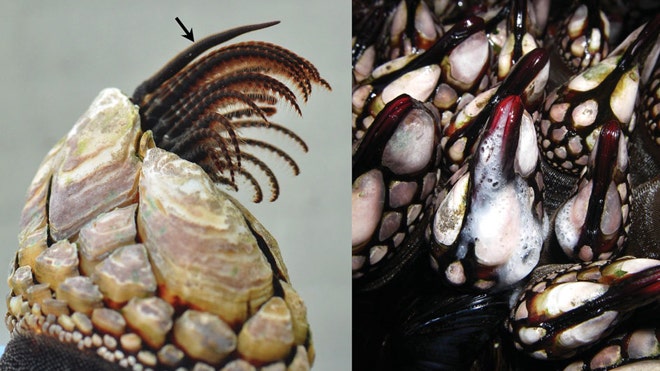Hey girl, I wanna catch your wave!
Think a longer penis will give you a better chance for copulation? The sessile barnacle species Pollicipes polymerus, might just prove this theory wrong.
This species of barnacle ( P. Polymerus ) is a hermaphroditic, stalked barnacle that inhabits wave-exposed intertidal shores of the northeast Pacific. Entrusting the waves and seawater as a medium to carry its sperms to another barnacle’s eggs!
Arrow pointing at a relaxed penis of a barnacle P.Polymerus
Fig. 1 Barnacles, Pollicipes polymerus
Barnacles are well known for having the longest penises of any creature for their size – up to eight times their body length — to seek out and have sex with their neighbors! Even though they are mostly hermaphroditic ( i.e. they can alternate between being a male or a female ) which means they can self fertilise, they hardly ever carry out reproduction that way!
The evolution of this crustacean shows what great lengths they go to ensure genetic variability and thus survivability of their kind. It is no wonder the geological history of barnacles can be traced back to 510 to 500 million years ago!
It sure isn’t easy to find a sexual partner when you are glued to a rock! Just when you thought long penises were all that was up the barnacle’s sleeves, they amaze us with yet another method of reproduction. A recent article ( 16th January 2013 ) in Proceedings of the Royal Society B, showed that Palmer and his team have carried out research to show that sperm casting was also another technique used by the barnacle species Pollicipes polymerus to copulate as well! This special species of barnacle are quite unusual because unlike its counterpart Balanus glandula ( see fig 2 below) its penis is much smaller and vary little in size throughout the breeding season.
Fig 2. Another species of barnacle with longer penis Balanus glandula
It was believed for a long time before that these barnacles ( P. polymerus ) tend to self fertilise when they are placed in isolated situations due to physical constraints like a shorter penis. However, researchers found out that isolated barnacles ( P. polymerus) carried DNA from another animal suggesting that they are not self fertilized! These barnacles actually fertilized through using seawater as a medium! A process known as spermcast mating. It is amazing how this little crustacean can make use of so many ways to carry out sexual reproduction!
So the next time you head for a swim at the shores with these barnacles around try not toswallow up too much seawater! You never know when you’ll be lapping up a barnacle’s chance of reproducing!(:
1. Journal Article – [Marjan Barazandeh, Corey S. Davis, Christopher J. Neufeld, David W. Coltman and A. Richard Palmer, 2013. Something Darwin didn’t know about barnacles: spermcast mating in a common stalked species,280, : 1-4 ]
2. Journal Article – [ Christopher J Neufeld and A. Richard Palmer, 2008, Precisely proportioned: intertidal barnacles alter penis form to suit coastal wave action, 275 :1-8 . ]
3.Article : “Barnacles trust their sperm to the waves” By Daniel Cressey, 16th Jan 2013, http://www.nature.com/news/barnacles-trust-their-sperm-to-the-waves-1.12220 ( Accessed on 1st April 2013 )
4. Article : “Barnacles Go To Great Lengths To Mate” by Science Daily, 7th Feb 2008, http://www.sciencedaily.com/releases/2008/02/080206150703.htm ( accessed on 1st April 2013)
5. Article: “For Barnacles, Sex Is a Real Stretch” By Charles Q. Choi, 6th Feb 2008, http://www.livescience.com/2266-barnacles-sex-real-stretch.html ( Accessed on 1st April 2013 )
6. Image: “New research shows some barnacles mate via spermcasting” , By Bob Yirka, 16th Jan 2013, http://phys.org/news/2013-01-barnacles-spermcasting.html ( Accessed on 1st April 1, 2013)
7. Image: “Barnacles Go To Great Lengths To Mate” by Science Daily, 7th Feb 2008, http://www.sciencedaily.com/releases/2008/02/080206150703.htm ( accessed on 1st April 2013)
